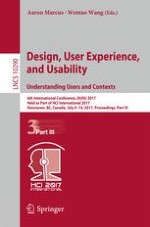The three-volume set LNCS 10288, 10289, and 10290 constitutes the proceedings of the 6th International Conference on Design, User Experience, and Usability, DUXU 2017, held as part of the 19th International Conference on Human-Computer Interaction, HCII 2017, in Vancouver, BC, Canada, in July 2017, jointly with 14 other thematically similar conferences. The total of 1228 papers presented at the HCII 2017 conferences were carefully reviewed and selected from 4340 submissions. These papers address the latest research and development efforts and highlight the human aspects of design and use of computing systems. The papers accepted for presentation thoroughly cover the entire field of Human-Computer Interaction, addressing major advances in knowledge and effective use of computers in a variety of application areas. The total of 168 contributions included in the DUXU proceedings were carefully reviewed and selected for inclusion in this three-volume set.
LNCS 10288: The 56 papers included in this volume are organized in topical sections on design thinking and design philosophy; aesthetics and perception in design; user experience evaluation methods and tools; user centered design in the software development lifecycle; DUXU education and training.
LNCS 10289: The 56 papers included in this volume are organized in topical sections on persuasive and emotional design; mobile DUXU; designing the playing experience; designing the virtual, augmented and tangible experience; wearables and fashion technology.
LNCS 10290: The 56 papers included in this volume are organized in topical sections on information design; understanding the user; DUXU for children and young users; DUXU for art, culture, tourism and environment; DUXU practice and case studies.
